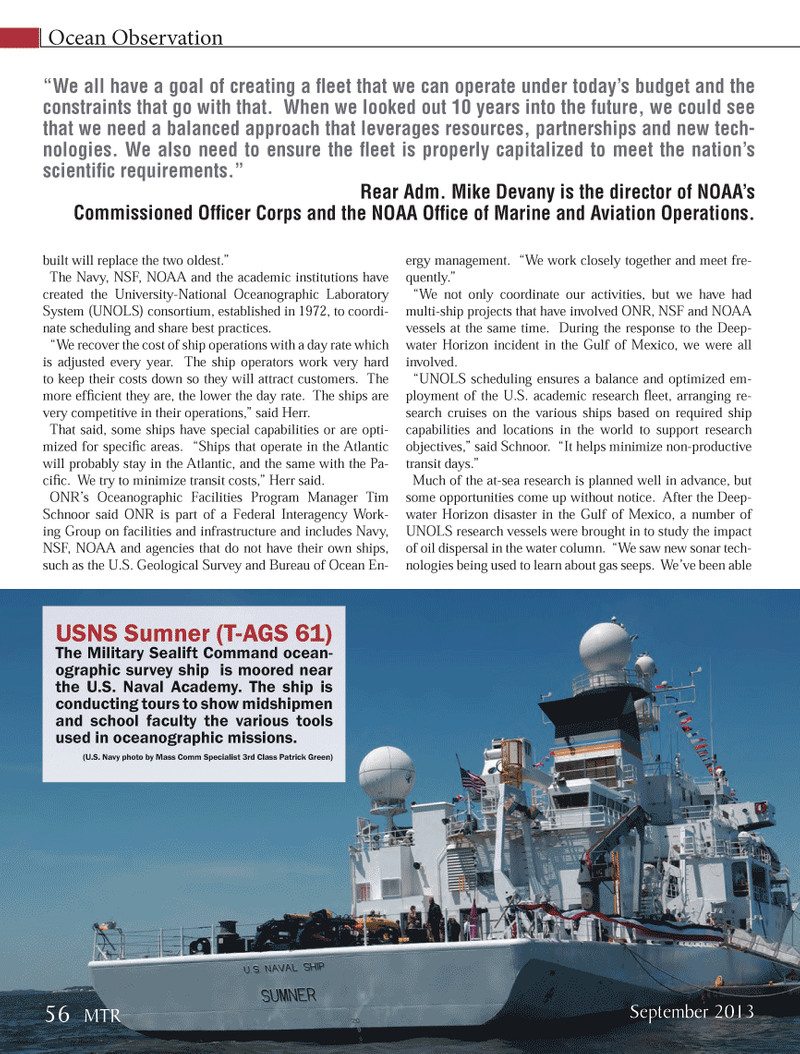
Page 56: of Marine Technology Magazine (September 2013)
Ocean Observation: Gliders, Buoys & Sub-Surface monitoring Networks
Read this page in Pdf, Flash or Html5 edition of September 2013 Marine Technology Magazine
built will replace the two oldest.? The Navy, NSF, NOAA and the academic institutions have created the University-National Oceanographic Laboratory System (UNOLS) consortium, established in 1972, to coordi-nate scheduling and share best practices. ?We recover the cost of ship operations with a day rate which is adjusted every year. The ship operators work very hard to keep their costs down so they will attract customers. The more ef cient they are, the lower the day rate. The ships are very competitive in their operations,? said Herr. That said, some ships have special capabilities or are opti- mized for speci c areas. ?Ships that operate in the Atlantic will probably stay in the Atlantic, and the same with the Pa- ci c. We try to minimize transit costs,? Herr said. ONR?s Oceanographic Facilities Program Manager Tim Schnoor said ONR is part of a Federal Interagency Work- ing Group on facilities and infrastructure and includes Navy, NSF, NOAA and agencies that do not have their own ships, such as the U.S. Geological Survey and Bureau of Ocean En- ergy management. ?We work closely together and meet fre- quently.? ?We not only coordinate our activities, but we have had multi-ship projects that have involved ONR, NSF and NOAA vessels at the same time. During the response to the Deep- water Horizon incident in the Gulf of Mexico, we were all involved. ?UNOLS scheduling ensures a balance and optimized em-ployment of the U.S. academic research eet, arranging re- search cruises on the various ships based on required ship capabilities and locations in the world to support research objectives,? said Schnoor. ?It helps minimize non-productive transit days.? Much of the at-sea research is planned well in advance, but some opportunities come up without notice. After the Deep- water Horizon disaster in the Gulf of Mexico, a number of UNOLS research vessels were brought in to study the impact of oil dispersal in the water column. ?We saw new sonar tech- nologies being used to learn about gas seeps. We?ve been able Ocean Observation USNS Sumner (T-AGS 61) The Military Sealift Command ocean- ographic survey ship is moored near the U.S. Naval Academy. The ship is conducting tours to show midshipmen and school faculty the various tools used in oceanographic missions. (U.S. Navy photo by Mass Comm Specialist 3rd Class Patrick Green) ?We all have a goal of creating a eet that we can operate under today?s budget and the constraints that go with that. When we looked out 10 years into the future, we could see that we need a balanced approach that leverages resources, partnerships and new tech-nologies. We also need to ensure the eet is properly capitalized to meet the nation?s scienti c requirements.? Rear Adm. Mike Devany is the director of NOAA?s Commissioned Of cer Corps and the NOAA Of ce of Marine and Aviation Operations. September 201356 MTRMTR #7 (50-65).indd 56MTR #7 (50-65).indd 568/22/2013 11:29:12 AM8/22/2013 11:29:12 AM

 55
55

 57
57
